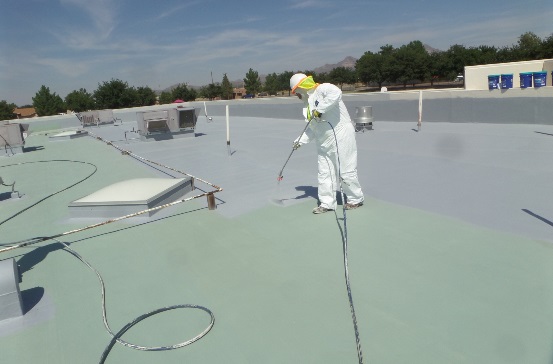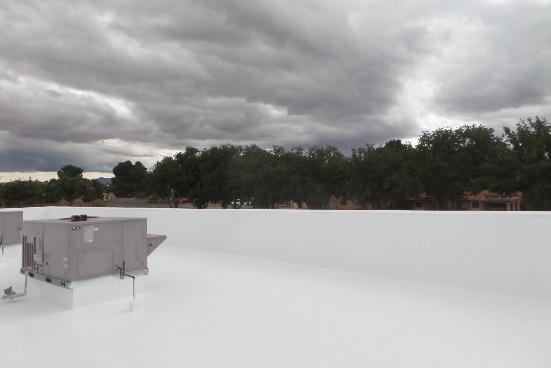Kids need the right environment to do their best in school. Many different strategies and styles have been tried over the years but one thing that is clearly not conducive to learning (or much else, for that matter) is a leaking roof.
For the students, teachers, and staff at Doña Ana Elementary School in New Mexico, the letter L was for Leaks. Lucky for them, a coatings crew from RoofCARE was on the job. They strove to get the job done right, which meant safely and quickly, and as a roof coating crew it’d be even better if they achieved the school’s motto: Going above and beyond for every child every day!
Changes Up Top
With 11 different roof sections to tackle and five months to make it happen, there was no room for delays. To help keep things moving, the crew kept a main staging area on the ground and assembled materials and any necessary equipment up top.
“We loaded the roof in sections and staged the material so that it was evenly spread out. That way, material was always convenient for the guys as they worked their way across the roof,” RoofCARE’s Project Manager Sam Rowan explained.
They kept flags around the staging area, labeled everything clearly, and worked with a consultant and the public school facilities authority to keep things transparent.
First up was to identify areas that needed to be replaced.
Rarely, what’s showing on a roof can explain what lies beneath. At Doña Ana, although infrared imaging didn’t show areas where moisture was in the scrim, the Tramex moisture scanner did. Where the rubbery top layer of the TPO (thermoplastic polyolefin) was wearing out, the scrim layer was exposed to the elements and “wicking moisture in,” according to Rowan.
The crew, made up of 5 to 10 people depending on the task, removed any saturated areas using shovels. They replaced those areas with new ISO and a self-adhering TPO. With a renewed substrate, they moved onto cleaning all roofs with 3,800 psi (26.2 MPa) pressure washers from DeWalt.
“The cleaning of the roof beforehand makes way more noise than actually installing the product,” Rowan said. “So we kind of tried to coordinate the pressure washing around where classes were so that wouldn’t bother them too much, but when it came to installing the system they really hardly even noticed that we were up there.”

That system started with GAF’s three-step method around penetrations and curbs: One layer of HydroStop FoundationCoat, embedded polyester fabric, and another layer of HydroStop FoundationCoat. The crew used stiff bristled brushes to lay down those coatings, which were applied to a total rate of 25‒40 square feet per gallon (0.6‒1.0 m²/L).
After this dried, the crew came back and applied the star of the show: HydroStop FinishCoat. Using a Speeflo spray rig from Titan, the crew applied four layers of the coating to achieve an average total thickness of 70 square feet per gallon (1.7 m²/L). Each layer was tinted a different color — white, gray, or tan — to ensure proper coverage.
The gas lines got a facelift, too. Those were painted yellow to meet safety regulations.
“One of the best ways that I know to do it is really just to kind of make every section complete as you go,” Rowan explained. The initial pressure wash was completed by one team that worked its way across the roof sections. “But once that happens, really just stay on that section until everything is complete: the flashing goes down, the gas pipes are painted yellow, and everything before we jump up to the next section,” he said. “That way you’re not trying to walk back over the whole thing and try to remember what needs to be done. You just take care of everything in the punch list one section at a time as you go.”
Delayed Opening
RoofCARE could incur penalties if they missed the finish date, but weather delays were an exception. After all, the project started in July, and summertime is when monsoon season hits New Mexico. RoofCARE’s strategy to avoid being topside when a storm hit was to check the forecast every morning. If there was a 20 percent chance or more of rain throughout the day, Rowan would count that as a weather day. “And then I’d upload that into our customer resource management software also just so everybody was on the same page,” he said.

Even days when the forecast said no rain, the crew occasionally still saw some rain clouds once on site. Rowan took pictures of the sky and uploaded those into the Kickserv software. Any chance of rain — from the forecast or the sky — meant no coatings. “We didn’t put anything down on the days when we thought it was going to rain, so we didn’t have any issues at all,” Rowan explained.
Staying off the roofs during potential thunderstorms kept the crew safe, as did using warning flags 6 feet (1.8 m) from the roofs’ edges. The crew also wore safety gear, such as safety glasses, vests, hard hats, and gloves, which they got from Grainger. When they worked outside of the perimeter flags, they wore harnesses and safety lines.
Principal’s Approval
RoofCARE was given the reins and kept moving forward until the last day on the job in December. “They said ‘go,’ and with the exception of the weather and maybe a couple days that they didn’t want us up there, we just started it up, ran it, finished it, and everybody was happy with it. Even the principal said that she was really happy with it compared to other construction projects ‘cause it didn’t really affect their day to day function in the classroom,” Rowan said.
According to Rowan, this 79,558-square-foot (7,391.2 m²) project couldn’t have been done without Alberto Carrasco. “I gotta give props to our foreman on that crew,” Rowan said. “He is well versed in running big projects, and I couldn’t have done it without the guy. He runs a really tight crew.”
But it was Rowan who met the client’s motto to go above and beyond. “RoofCARE was responsive to our questions about the project and participated in regular meetings with all stakeholders,” said Principal Cherie Love. “I was very impressed with Sam Rowan, the project manager, who attended our Annual Open House, parent meetings, and our Fall Harvest Festival to provide information and to answer questions from staff, our parents, and our local community.”
And with that, the RoofCARE crew was able to take L for Leaks and turn it into V for Victory.
Editor’s note: This project won third place in CoatingsPro’s 2017 Contractor Awards Program.
